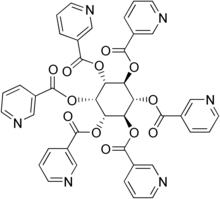Inositol nicotinate, also known as inositol hexanicotinate or inositol hexaniacinate, is a compound of niacin (vitamin B3) and inositol. It is marketed in the United States as a "no-flush" form of niacin in dietary supplements.[1]
 | |
| Clinical data | |
|---|---|
| Trade names | Hexopal |
| AHFS/Drugs.com | International Drug Names |
| Routes of administration | oral |
| ATC code | |
| Legal status | |
| Legal status |
|
| Identifiers | |
| |
| CAS Number | |
| PubChem CID | |
| ChemSpider | |
| UNII | |
| KEGG | |
| CompTox Dashboard (EPA) | |
| ECHA InfoCard | 100.026.806 |
| Chemical and physical data | |
| Formula | C42H30N6O12 |
| Molar mass | 810.732 g·mol−1 |
| 3D model (JSmol) | |
| Melting point | 255 °C (491 °F) |
| |
Mechanism of action
editWhen ingested, inositol nicotinate breaks down into inositol and niacin. The niacin component helps widen blood vessels (vasodilation), lowers blood lipid levels (including cholesterol), and inhibits a protein involved in blood clotting.[1][2]
Uses
editInositol nicotinate is used to treat blood circulation problems, including:
Some research shows it can improve symptoms of Raynaud's phenomenon over several weeks. However, its effectiveness in treating other conditions like:
- High cholesterol
- High blood pressure
- Leg pain during exercise (due to poor circulation)
remains unclear, with studies producing mixed results.[1][3]
Other proposed uses, such as for:
have insufficient supporting evidence.[1]
Side effects
editInositol nicotinate is generally safe when taken by mouth, but possible side effects include:
- Stomach upset
- Intestinal gas
- Nausea
- Liver damage (similar to other niacin products)[1]
It is marketed as "no-flush" niacin, but research suggests that the lack of flushing may be due to its limited conversion to active niacin.[4]
Precautions
editInositol nicotinate should be used with caution in individuals with certain conditions:
- Diabetes: May raise blood sugar levels. Diabetic patients should monitor their blood sugar levels closely.[1]
- Liver disease or kidney disease: Niacin can accumulate in people with liver or kidney problems, potentially worsening their condition.[1]
- Bleeding disorders: Inositol nicotinate may slow blood clotting, increasing the risk of bleeding for individuals with clotting disorders or those undergoing surgery.[1]
- Gout: Large amounts of niacin may trigger gout attacks.[1]
References
edit- ^ a b c d e f g h i "Inositol Nicotinate". WebMD. Retrieved 11 September 2024.
- ^ Tomlinson, B (2014). "Niacin and inositol hexanicotinate for hyperlipidaemia and vascular disease: new data and new uses for an old drug". Journal of Clinical Pharmacy and Therapeutics. 39 (1): 1–12.
- ^ Head, A (1986). "Treatment of intermittent claudication with inositol nicotinate". Practitioner. 230 (1411): 49–54.
- ^ "Niacin: The facts on flushing". BC Drug & Poison Information Centre. Retrieved 11 September 2024.